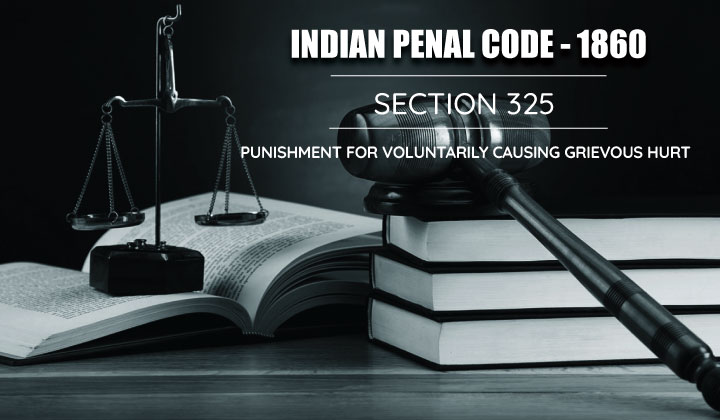IPC Section 325 - Punishment for Voluntarily Causing Grievous Hurt

We keep hearing about physical fights between people on roads, railway and metro stations, and malls, and sometimes they turn very serious and one of the parties or even both end up getting grievous hurt. If there is a minor bruise here and there, it is not much of a problem, but it is an offence if the wound is deep or there is some permanent damage done to the body, which might be curable but does leave an impact for years to come or for a lifetime. It is an offence under Section 325 of the Indian Penal Code. However, specific laws define the punishment according to how atrocious the wound or the injury is—different sections of the Indian Penal Code deal with different levels of injury caused by a physical fight.
Section 323- When the fight leads to a little swelling (which results from an infection or an injury), IPC Section 323 is applicable. This section's punishment is imprisonment for a year or a fine of up to a thousand rupees or even both.
Consult the best lawyer online
Section 324 - When the fight involves dangerous weapons through which one of the parties gets injured or cut as deep as half an inch on any of the body parts, IPC Section 324 is applicable. It is also useful when some corrosive substance is used, which is capable of causing damage to the human body when inhaled or swallowed. The punishment mentioned in this section involves imprisonment of up to 3 years, a fine, or both.
What Is IPCÂ Section 325

Section 325 deals with ‘Punishment For Voluntarily Causing Grievous Hurt’. This Section is applicable when someone intentionally does harm to another person. The harm should be severe, which impacts his body throughout his lifetime or affects his future, like fracturing a bone, misplacing a bone, and so on. The offender must know that his act might also lead to the victim's death and still perform the act intentionally. Those cases would not come under Section 325, which are genuinely caused by mistake and without intention to harm. This crime comes under criminal law. When the hurt is grievous- fracturing a bone of the victim, depriving him of his strength, damaging the eyesight, impairing or deform the head or the face, broken tooth, or even when due to the injury, the victim has to be in severe pain thereby making him unavailable to his day to day work. The punishment for the offence under this particular Section is imprisonment of the culprit or the offender. Â
Nature of offences under IPC Section 325:Â
It is a cognisable offence. A cognisable offence is when the police officer may arrest the accuser without a warrant. It is also a compoundable offence with the approval given from the court, which means that a fine or, imprisonment or even Both are given as a punishment. The offence is a bailable offence. However, a criminal lawyer who can help get the bail without difficulty must be hired. The police, after being reported with such a case, will arrest the culprit. But if the person feels innocent, he can file for an anticipatory bill. There is no surety that he would not be inside the bars at all. The magistrate can put him under arrest for a day or two until they get a hearing in the court. The police officer has to present the case to the court within 90 days. The court will follow its procedure. First, the plaintiff’s side would be heard, followed by the defendant or the accuser.
Is IPC Section 325 Bailable or Not?

Yes, IPC Section 325 is bailable, which is the type of offence for which the police can arrest the accused without a warrant because bailable offences are usually of a grave and serious nature.
What Is The Punishment For the IPC 325 Case?

The punishment for IPC Section 325 case is imprisonment for up to 7 years, a fine, or both.
IPC 325 Cognisable Offence or Non-Cognizable Offence?
IPC Section 325 is a cognizable offence, which means violations that are horrific crimes that affect the whole society. Any magistrate can try it.
How To File/Defend Your Case For The IPC 325 offence?
Since IPC Section 325 is a bailable and cognisable crime, hiring a good lawyer to fight the case for you is always recommended. Lawtendo is a law-tech company with around 15,000+ lawyers across India on our platform who can help you file/defend your case for IPC Section 325. Lawtendo aims to facilitate legal services/advice provided to clients that are cost-efficient and quality. You can contact us at +91 967133666 or [email protected].
Difference Between Section 335 and Section 325
Both these sections deal with voluntarily causing grievous hurt, but the difference between them is that Section 335 deals with the harm caused after provocation and not to cause damage but only to protect himself. Section 325 deals with causing the harm voluntarily and to cause harm. All the wounds and injuries not included in Section 335 come under S 325.
Get in touch with the best criminal lawyer
Conclusion: Everyone tries to be safe in every situation; they protect themselves, but in some cases, they still get hurt. Instead of sulking about it and thinking of taking revenge by attacking back, it is wiser to take a step back and backfire with legal action. Hope this blog was helpful for you in gaining some insight into the legal remedies available for different types of injuries caused by the accuser intentionally.
This beautiful article on IPC Section 325 was drafted by Ms. Ishika Choudhary, BALLB – 2nd year, Amity Law School.
| Offence | Punishment | Cognizance | Bail | Triable By |
|---|---|---|---|---|
| Voluntarily causing grievous hurt | 7 Years + Fine | Cognizable | Bailable | Any Magistrate |
| Offence | Voluntarily causing grievous hurt |
|---|---|
| Punishment | 7 Years + Fine |
| Cognizance | Cognizable |
| Bail | Bailable |
| Triable By | Any Magistrate |


